All profits to

Archive Home Page
Previous Exhibition Following Exhibition
Tithe Barn, Cheltenham Road, Bishop's Cleeve, GL52 8LU
All profits to |  |
Descriptions are based on material supplied by the layout owners
Abbotswood Junction Abbotswood Junction is a father and son collaboration between Phil and James Bullock. The prototype is situated just south of Worcester, where the ex LMS Gloucester to Birmingham line is joined by a chord from Norton Junction on the ex GWR Worcester to Oxford line. This is a OO layout featuring DCC Sound and working semaphore signals. The layout is a trains in the landscape layout and is set in the period 1967 to 1973; end of steam to TOPS period, although we may stray to 1977. Green and blue diesels running on trains representative of the period at this location are featured; and preserved steam could appear! The premise is that the Stratford to Cheltenham line closed when through services finished in 1965 and so the layout at Abbotswood has had to be expanded to accommodate extra trafnc. An up loop with a direct connection to the Worcester chord (this was only ever a kick back siding) has been laid in and the layout has been resignalled to accommodate this prior to the Gloucester MAS scheme. Unfortunately there has recently been a derailment on the Worcester chord so all services are having to run via Bromsgrove, this is until phase 2 of the layout including Norton Junction is built. Trains to watch out for are the Cornishman and the Devonian, but perhaps freight is more interesting with the Waterston to Albion tanks booked for a pair of 37s, the St Blazey to Etruria clays booked for a Western and the Malago Vale to Worcester vans booked for a Warship. One joy of this location was that you could never be quite sure what might turn up; so a few surprises might also be in store. Hope you will join us for a while to watch the trains go by... | 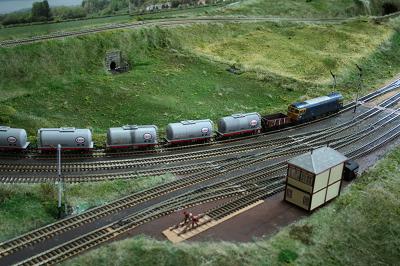  | |
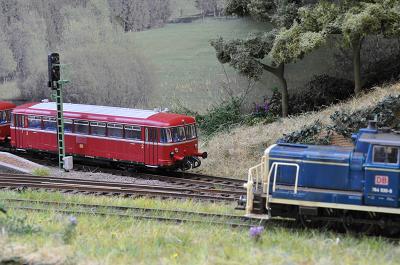 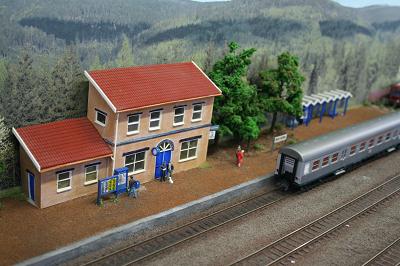 |
Bad Horn represents a branch line terminus in the Teutoburg Forest, Central German Uplands, around the turn of the millennium. The station sees passenger trains from Paderborn formed of railcars or push-pull coaches as well as wagonload freight services. Though Germany's railways were unified a few years previously, the stock is predominantly of Bundesbahn (West German) origin, most still carrying their old liveries with just a change of logo signifying the new organisation. Trackwork is Piko, the working signals are Viessmann and train control is Roco DCC. Sometimes I operate the layout with former East German stock representing the Ore Mountains in Saxony, though strictly speaking the signals are incorrect for this area. | |
Badger's Quay | 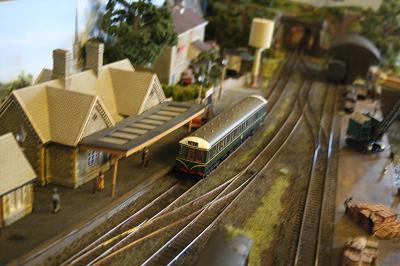 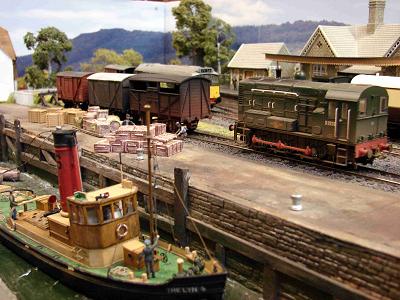 | |
  |
Until recently when travelling either North or East from Bristol Temple Meads you could view from the train window the English, Welsh and Scottish Railways deport of Barton Hill. This is now hidden by more recent buildings, but just a few years ago it was a Rail Express Services Depot hosting a range of red liveried postal rolling stock. This model is intended to give an impression of that depot. Baseboard construction is of plywood, Peco track is laid on a cork base and electric point motors are a mixture of Peco and Seep. Railfreight wagons are fitted with Peco uncouplers to enable "hands off" operation by means of strategically placed electro magnets. Some modelers license is used so that I can run what I like to enable me to play trains. | |
Cheltenham South & Leckhampton Cheltenham South and Leckhampton was the last station on the Great Western Banbury and Cheltenham Direct Railway before it joined the main Birmingham to Bristol line just south of Cheltenham. The line was built in the late 19th century and doubled in 1908. It is this latter condition that we have attempted to model. It was a compact site and although not modelled to full size there has been only a small amount of compression to keep it to a managable size. The layout is finescale "00" and the buildings are scratch built from the few plans available and photographs from various sources. While it may not be totally accurate, we have been assured by those that knew the location that we have captured the essence of the site. It is normally operated with GWR stock representing the mid 1930s, although little changed over the years until closure in 1962 so it would be possible to run BR stock. We do not operate to a timetable as there was only something like five trains per day and that would be rather boring for us all. Little remains today other than the bridges at each end, the site being given over to flats and industrial units. | 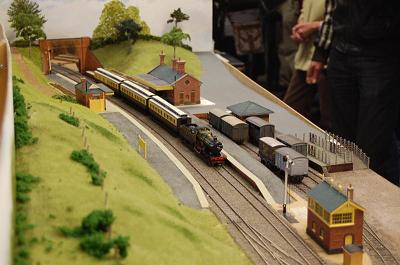 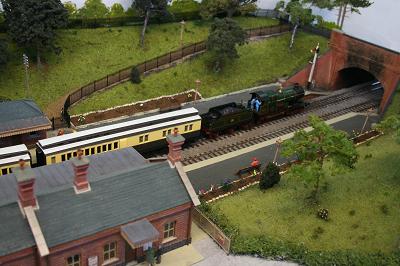 | |
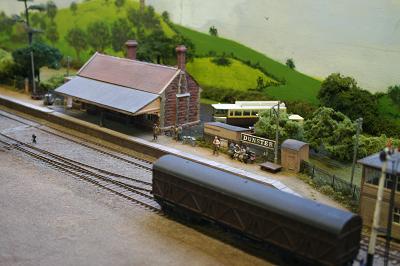 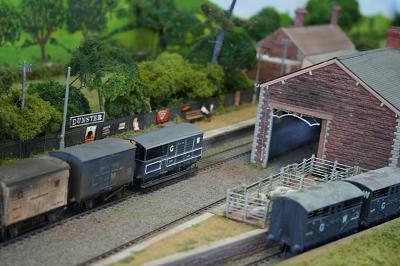 |
Dunster is a station on the now preserved GWR line to Minehead. It represents a basic branch line station in the 1930's-40's era. The station building is perhaps more elaborate than usual as this station served nearby Dunster Castle. Dukes and Maharajahs were visitors during the inter war years and polo was a very popular pastime. Horse boxes would have been regularly seen carrying the polo ponies. The station building and signal box are modified Hornby kits. The track is Peco finescale code 75 and the signals are Ratio operated by Fulgurex motors. The stock is a mixture of proprietary and kit built. | |
Durrell Park | 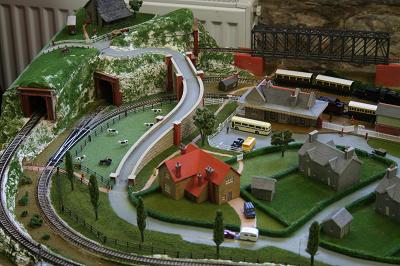 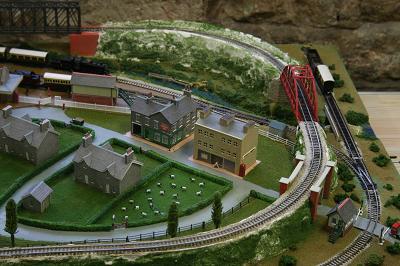 | |
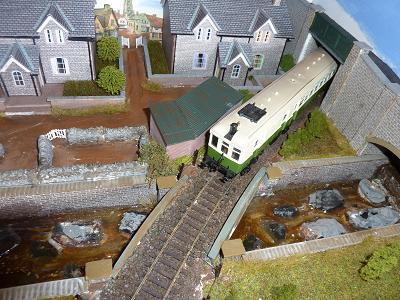 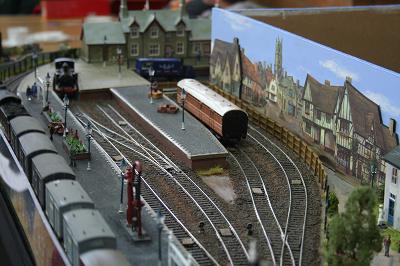 |
The Hull, Beverley and Scarborough Railway (HB&SR) was proposed to form a direct route between Driffield and Seamer Junction without having to use the coast route via Bridlington and Filey, or the inland route via Malton. The line from Driffield to Seamer was single track and was completed in 1846 with intermediate stations at Kilham. Langtoft, Elderdyke and Foxholes. The line was absorbed into the York and North Midland Railway. which controlled lines in the Hull, Whitby and Scarborough areas until 1854 when it amalga- mated with the York, Newcastle and Berwick Railway and the Leeds Northern Railway to form the North Eastern Railway. The North Eastern Railway con- trolled most of the lines in the North East of England between the Humber and the Tweed and became part of the LNER at the grouping in 1923. At Elderdyke there was a short branch to Clogger, to capture the vegetable traffic. Elderdyke was not the largest village on this section of the route, so was not blessed with a passing loop, but it was the most convenient location for the Clogger branch to join the route. There was a siding connecting the works of Moore's printers, who had acquired the contract. During the Second World War, to print ration books for the Government This generated a good deal of van traffic to and from the works. The agricultural traffic from Clogger, together with coal and general freight supported a viable goods service, but the passenger service was not well patronized. The time period for the layout is around 1946. The LNER are embarked on a re-numbering scheme, so some locomotives carry old numbers and some new. Passenger trains over the HB&SR never needed to be very long, three coaches usually being sufficient to cope with passenger numbers. The Clogger branch closed to passengers in 1958, although freight traffic continued until 1962 when the line from Driffield to Seamer closed to all traffic | |
Fryupdale Brewery The layout was built for the 2002 DEMU small layout competition which among other things, stipulated that it mustn't exceed an area of 654 sq ins and have at least one working point. The track plan was arrived at using points that we already had in stock and a traverser, to save space and allow hidden sidings plus connection to the run round and grain uploading shed. We chose to model a brewery as we like beer! Such a prototype would also allow industrial buildings and a variety of wagon types. The wagons that can be seen are opens, vans, coal, grain and the odd internal user. The buildings are from the Walthers meat packing warehouse kit, from which we got the main building (with loading dock) and grain unloading building. The baseboard is built as a single unit with legs that plug into pockets underneath. The layout gives a chance to show a varied display of shunters and wagon types, some which are scratch-built. We wanted to build a layout that would be of use beyond the competition and be interesting to operate too, as such it has exceeded the original design brief. | 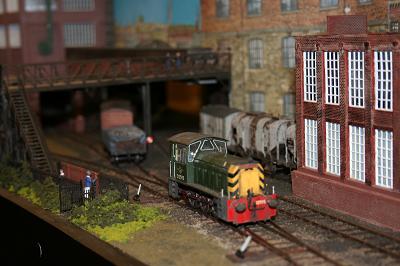 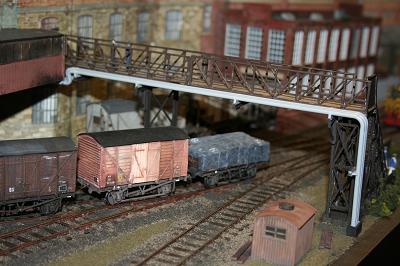 | |
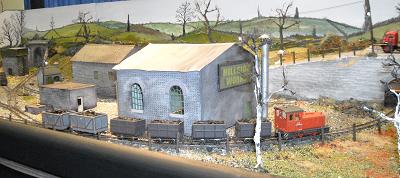 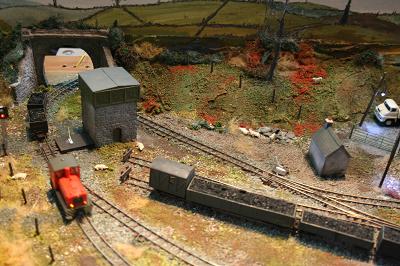 |
Hillside Works is a narrow gauge railway in 4mm scale, constructed using Peco 009 proprietary track. The location is set in the Welsh borders and the time period modelled is late sixties to early seventies. The concept and design of Hillside Works is purely fictional and an enormous amount of modeller's license has been used during all design and construction phases. The idea was to create an easily portable layout which provides sustained operational and scenic interest for the viewing public. Rolling stock is a mixture of kit built and converted ready to run items mostly from RICO and Parkside Dundas. The buildings are both kit and scratch built using Ratio and Wills materials, with various scatters from the Woodland Scenics and Greenscene ranges. The backscene has been built and painted to represent colder autumn skies and the surrounding hillsides of a typical Welsh border area. The trees are constructed using the traditional wire frame method, which is then hand soldered and covered in a plaster mix and painted to represent the bare branches that are to be found in the late November countryside of this region. Locomotives are operated by handheld controllers using DC cab control, with AC supply derived from a 15 volt transformer which has been safely electrically isolated, another transformer supplies the capacitor discharge unit, all have been hand built. The point motors are a collection of the older SEEP type and the more modern PECO type with base mounting adaptors. Working lamp posts and coloured light signals, together with their automatic control systems, have been specially constructed to scale for this layout from my own designs. Hillside Works as with all layouts is still "work in progress". Our aim for the future is to bring it into present day by turning it into a preserved railway, called Hillside Works Heritage Centre complete with working vintage machinery, tourists and cafe. | |
Journey's End ‘JOURNEY’S END’ features a narrow gauge railway serving a cemetery. It is entirely fictional, set “somewhere in England”, though inspired by the London Necropolis Railway that ran from Waterloo to Brookwood, Surrey, from 1854 until 1941. The narrow gauge dimension was inspired by the Golden Valley Light Railway in Derbyshire, which runs from the Midland Railway Centre at Butterley towards a natural burial ground. The setting is almost timeless, but can be dated by use of different vehicles anytime from the present back to the 1950s. A particular, and probably unique, feature of the layout is its ghost train, comprising several ghost figures (made by Aidan Campbell) hauled by a diesel loco with a ghost headboard. There are also several Ffestiniog Railway hearse vans, in different liveries, and a model of the LSWR hearse van, as used on the London Necropolis Railway, is under construction for use on the layout. Other rolling stock, including steam and diesel locos, is mainly by Roco or Liliput, with some kit or scratch-built items, including a double ended railbus. The basic structure – baseboard, track laying, wiring and controls – was professionally constructed in 2011 by Model Masters of Weston-Super-Mare. It has two tracks, independently operated, one a continuous loop, and several working features by Viessmann, including level crossing lights, a gravedigger (if he’s not too tired) and a man with a scythe (the Grim Reaper). A cemetery lodge and chapel are the main buildings on the layout, with several scratch-built mausoleum structures and platform waiting building also present. The gravestones and monuments are from a variety of sources, including Hornby, Harburn Hamlet, Dornaplas, Langley, Woodland Scenics, Busch, etc and the angel statues and other figures are mainly by Preiser and Noch. The mausoleums are mostly scratch-built, though two are adapted Hornby Skaledale structures. The vehicles are also from a variety of sources, the hearses and limousines being from Oxford Diecast, and there are some horse drawn hearses and carriages by Preiser. |  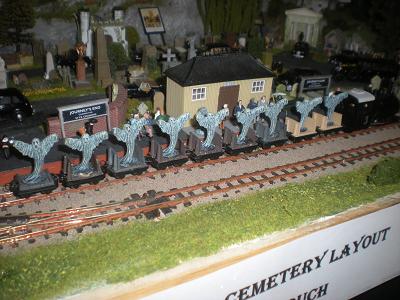 | |
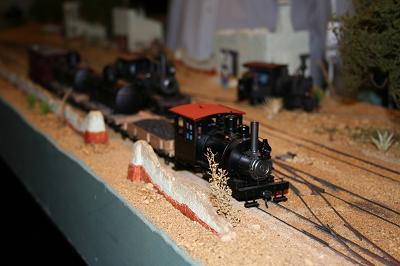 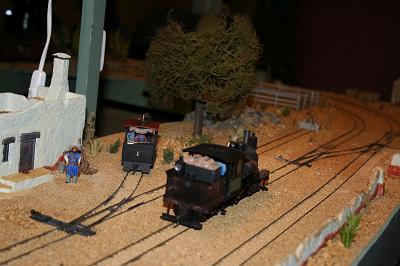 |
Once upon a time there was the West.... What else do you call a model railroad layout influenced by Spaghetti Westerns, Clint Eastwood and Sister Sarah? The layout has no historical base and we are not quite sure which State/Country it’s supposed to be set in either - Texas, Mexico or Spain, but there again who really cares? The layout is of standard timber and plywood construction, easy enough to transport but resilient enough to withstand the rigours of exhibiting. The track used is the run-of-the-mill Peco code 100 Set Track buried up to the rail heads in graded sand ballast. Additional scenic details include Anita Décor’s “cacti” and other unusual desert plants, as well as two real cacti. The majority of locomotives, passenger and freight cars are from the Bachmann 0n30 range, most either heavily weathered or kit-bashed. Some of the freight stock has been re-wheeled and also fitted with scale Kadee couplings. The electrics are the usual 12 volt DC as we like to keep this aspect of the layout as simple as possible. The switches (points) are all manually operated. The most unusual feature of the layout is the buildings and figures. The buildings are all resin castings produced for the wargaming market with the figures being produced for the same. | |
North Bridge Northbridge is the fictitious location set on the old Westbridge branch in Leicester and is where trains from Coalville and Burton on Trent terminated. The period modelled is the early 1960s and the infrastructure is based on but not a copy of what might have been there. For operating purposes the passenger service still exists and an additional Push Pull service has been invented from Leicester London Road. The goods yard at Westbridge was in reality very much larger and even in the mid 1960's was still quite busy with coal, oil and general traffic and suitable trains are run to incorporate this. The trackwork is Peco code 100 with small radius electrofrog points and is DCC operated. Rolling stock is a mixture of propriety products, some modified and all weathered to some degree and indicative of what might have been seen in the area had the bore of Glenfield Tunnel been more generous. Many of the buildings are from the Metcalfe range, all altered in some way to fit the location. The overall size of the layout is 260mm x 430mm and folds in half to form a box 350mm deep, it has been an exercise to see how much can be achieved in a small space. | 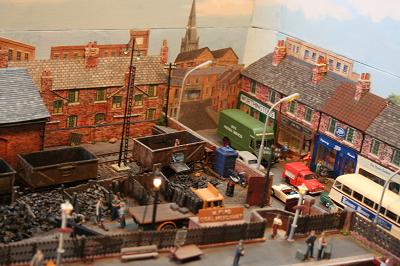 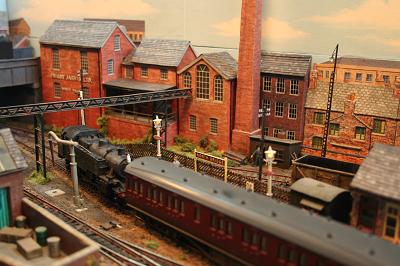 | |
 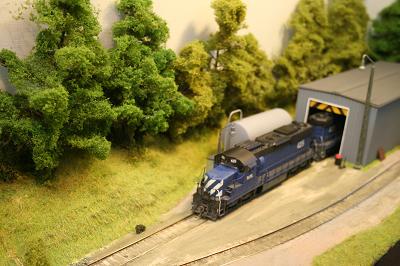 |
Othmar Yard is on the White Mountain Railroad just to the east of Wells River Junction in New Hampshire. The White Mountain operates on a short length of former Boston & Maine trackage, serving a number of small industries. Short workings from Wells River Junction into Othmar Yard are regularly worked by Vermont Systems or Guilford System (now Pan-Am) locos, the White Mountain running the services that continue through the yard and further to the east. There is also a small locomotive maintenance facility here. Industries here include Gray Concrete, Schroeder Chemicals and Van Pelt Plastics. Further east (off stage) are Franklin Feedstuffs and ReRun Lumber. This layout was built to display an increasing amount of HO American outline stock being collected for a larger, still under construction, project. A mix of code 75 and code 100 rail is used with points modified for DCC control. Buildings are modified Walthers Cornerstone, Pikestuff or scratchbuilt from Wills sheets. Grass is Noch Electrostatic, with trees and foliage from Woodlands Scenics. Locomotives are all Atlas 'Gold Series' with DCC sound chips. Control uses a Digitrax Super Chief system. | |
Pixash Lane My main modelling interest is US rail roads but this project was conceived when Hattons announced their special run Class 14 diesel to be made for them by Heljan just after we had had an excellent day on the West Somerset Railway being pulled about by two of the same class of locomotive. "Pixash Lane" is based near Bristol and the industries modelled are loosely based on those served by local trip workings on the main Bristol to Bath ex-GWR mainline near Keynsham. Most of the buildings are scratch-built and are assumed to be on a short branch line with a halt and occasional passenger services. Most of the rolling stock is typical of the area and era - including the adjacent ex-SDJR line to Bath Green Park but we do allow ourselves plenty of licence. We normally operate using DCC - between us we can provide NCE, Lenz and Digitrax systems - and the stock is a mixture of ready to run and kits and is equipped with the US Kadee couplers which allows some hands off operation. Track is a mixture of Marcway and SMP with some Peco "off-stage". | 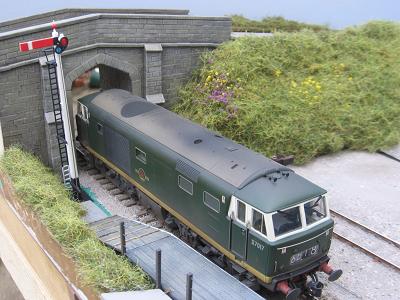 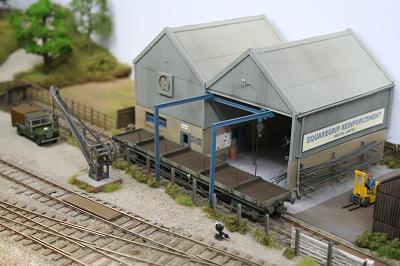 | |
  |
Set in the coal-mining region of the Appalachians the layout represents scenes from the last decade or so on what is now the Norfolk Southern (NS) railroad. The NS was the result of a merger between the Norfolk and Western and Southern railroads. The Southern was noted for the efficiency of its operations and the N&W for its coal hauling. The mine on the upper level is typical of an older type of unit during the last days of its life loading bottom discharge hopper cars bound for the few industries that still need this type of unloading. The cars are taken from the mine and eventually reach an interchange with the main tracks on the lower level. On the lower level can be seen the modern unit coal trains which need rotary tipplers to empty them as they do not have doors on the bottom. These cars run in long block trains from the mines to the power stations or other big users. Others trains to be seen include wood chips in very large gondolas,roadrailers, manifests (mixed), intermodaT and MoW (engineers) trains. Red River featured in the January and February 2005 editions of 'Continental Modeller' and has been shown at Banbury (NScaleUK), Lydney, Ross (NMRA), Chippenham (Trainwest), Caine, Andover (Modelex 2005), Rhondda (S. Wales Model Show), Cheltenham, Abingdon, Alton, TOlworth, High Wycombe, Warley (NEC), Rail-Ex Southwest (Taunton), Derby and Truro (Three Spires Railex). | |
Stonebridge Stonebridge is the group’s first venture into layout construction using S.M.P. Trackwork. A quantity of ready made points and flexible track were purchases secondhand, glued onto cork and then ballasted with ‘N’ gauge granite ballast. Buildings on previous layouts have been scratch-built but in order to save time, kits have been used here to good effect. The goods shed and loco shed are modified Heljan and Airfix respectively, whereas the station building was put together without any modification at all. The platform mounted signal box is also Ratio and boasts a fully fitted interior. Working signals always enhance a model railway and although only two are featured here they add another dimension to the railway scene. Perhaps in the future it may be possible to have operating ground signals. Figures bring a layout to life and these have been painted from various sources and most of the road vehicles have been altered in some way. Locos are a mixture of steam and diesel and, together with appropriate stock, trains are portrayed running in the B.R. Early 60’s period. Stonebridge is now 20 years old and was exhibited at Cheltenham for the first time in October 1987. | 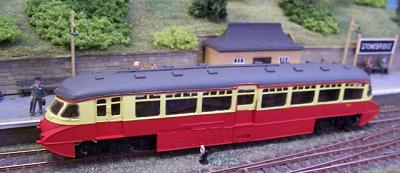 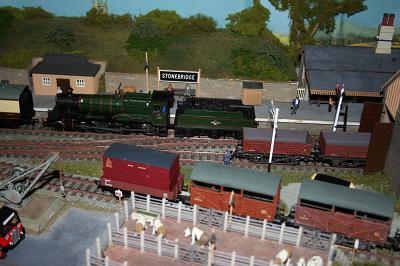 | |
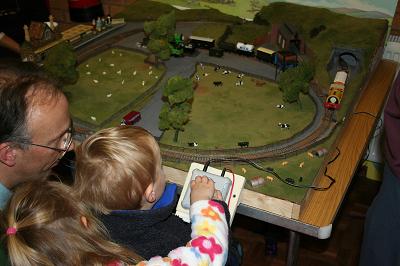 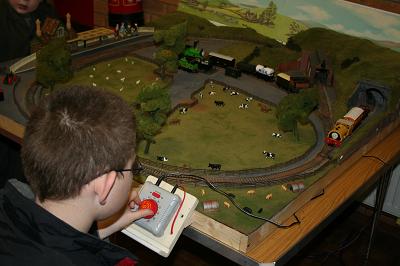 |
We would like to thank Trevor Hallam for looking after the Thomas Layout for many years at our exhibitions and also for refurbishing it at his expense. Unfortunately because of ill health Trevor is no longer able to continue so it was decided to offer Thomas free of charge to Hucclecote Railway Modellers on condition they bring it to all of our future exhibitions. This is the model railway where Children can become Engine Drivers on the Island of Sodor and has of course been inspired by the Reverend Audrey books. Our Thomas and Friends layout has been built for ten years now and in that time we hope it has encouraged many new railway enthusiasts to build a train set of their own. Originally it was intended as a space filler at shows so needed to be small, easy to transport and have a simple track plan, easy for small children to operate. After its first appearance it was clear this model railway would have to be included at all our exhibitions. It incorporates a tunnel, station, level crossing together with locomotive and goods facilities. Train drivers should look out for many of the popular characters; Henry, Percy, Toby, Cranky, the Troublesome Trucks, not forgetting the Sir Topham Hatt better known as the Fat Controller. The famous anthropomorphised rolling stock is mostly from the Thomas range and we are sure most of the adults and all the kids will love it. Happy Driving, but please observe the track speed limits. | |
Westbridge Westbridge is a fictitious exhibition layout based on the Western Region during British Rail's blue diesel era in the early 1970's. It is modelled in OO gauge and includes a small terminus station, sidings and a scratch built three road traction maintenance depot. The track is Peco Code 75, control is DCC via a NCE Powercab.
Locomotives are a mixture of Bachmann and Heljan and the majority of rolling stock in Bachmann. Since it was last at the Cheltenham show, the layout has been extended by three feet, this gives me much more operational interest whilst exhibiting. Regular passenger services terminate and depart from Westbridge, these are operated either multiple unit or mk1 carriage stock. There are also occasional parcel trains, which can also be either locomotive hauled or operated by units. A station pilot is always present and occasionally shunts stock sitting at the platforms. Westbridge Traction Maintenance Depot is always busy. Operations including light engine movements or oil tankers, which serves the fuelling point. We hope you enjoy Westbridge as this is my first attempt at an exhibition layout that I built at the age of fifteen. | 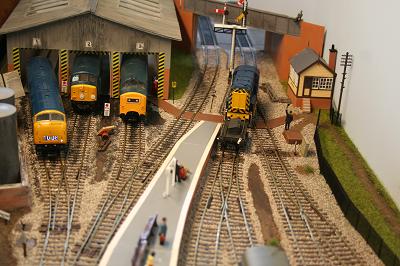 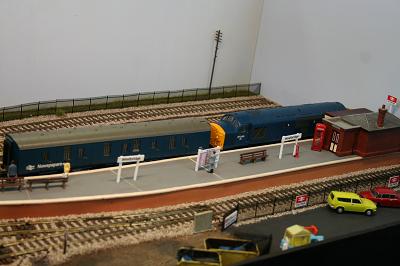 | |
| Displays | ||
Carlton | Ffestiniog Railway WEBSITE | |
South Downs bus rally & vintage show | Model Fairground . | |
Mini scenes | Newtown 1960-ish | |
| Modelling Demonstrations | ||
| Mark Begley | ||
| Trade | ||
| Cheltenham Model Centre WEBSITE | Elite Baseboards WEBSITE | |
| Penduke Models WEBSITE | RCSW (Pre-owned) Models, Clive Reid | |
| Rly books, timetables, photos, Stewart Blencowe WEBSITE | ||